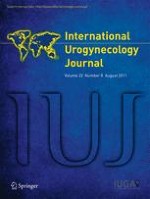01-08-2011 | Clinical Opinion
Mixed urinary incontinence—time to uncouple urgency from stress?
Published in: International Urogynecology Journal | Issue 8/2011
Login to get accessAbstract
Introduction
“Mixed incontinence” is defined as a combination of stress and urge symptoms. Over time, it has morphed into a single entity, encompassing etiology and treatment. My perspectives are: (a) Stress incontinence (SI) and urge incontinence (UI) are different symptoms with often different anatomical causation and so should be treated separately; (b) It is illogical to group urgency with SI. Urgency may also be associated with frequency, nocturia, abnormal emptying and pelvic pain in patients with no SI (“posterior fornix syndrome”); and (c) There is growing evidence that urgency may be cured by surgical correction of a cystocele and/or apical prolapse in up to 80% of patients who do not have SI. In this anatomical context, sensory urgency, urge incontinence and urodynamic detrusor overactivity may all be hypothesized as different manifestations of a prematurely activated micturition reflex, caused by a lax vagina’s inability to support bladder base stretch receptors. This statement can be tested with a simple clinical test, “simulated operations”, whereby digitally supporting in turn the midurethra, bladder base and posterior vaginal fornix may cause a significant decrease in the urgency felt by the patient.
Conclusions
The term “mixed incontinence” is only valid if both symptoms are caused by a lax pubourethral ligament. However, urgency may be caused by laxity in other parts of the vagina. Regarding stress and urge as separate entities will remove the confusion resulting from this definition, creating new directions for science and therapy.





